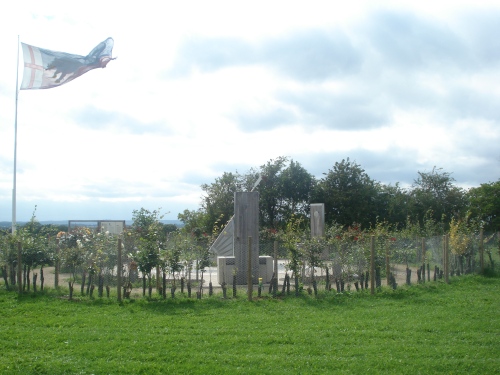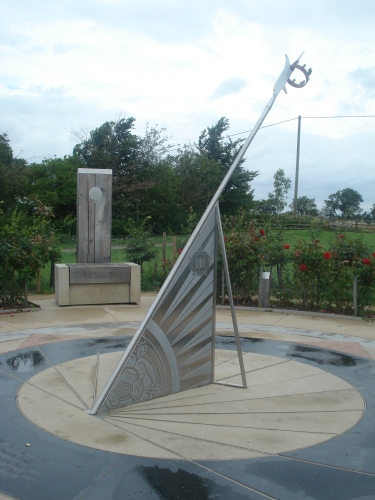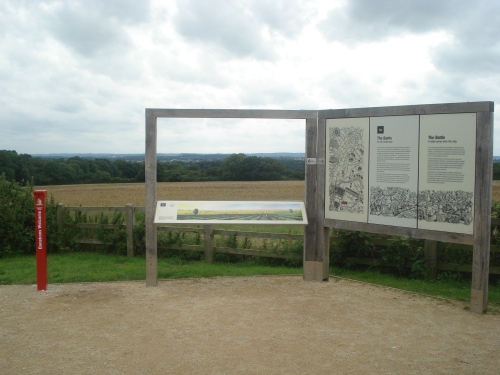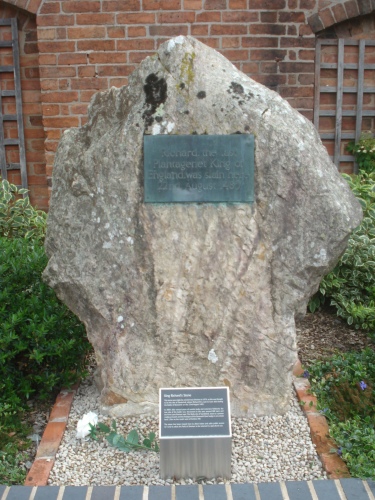by Frances Casey, Project Manager
Last week, a ceremony took place at the memorial sundial at the Bosworth Battlefield Heritage Centre to commemorate those killed at the Battle of Bosworth on 22nd August 1485. This was the first anniversary to take place at the scene of the battle since the discovery of the body of King Richard III at the site of Greyfriars Church, Leicester in September 2012. Richard III was killed at the Battle of Bosworth as he tried to defend his reign of just over two years against a claim to the throne of England made by Henry Tudor, Earl of Richmond.
Rather than lay wreaths at the sundial, participants at last Thursday’s event held a rose-laying ceremony. The roses make reference to the Wars of the Roses (1455-1487), the civil war between Richard III’s house of York (white rose) and the house of Lancaster (red rose), from which Henry Tudor descended.
With the death of Richard III, the Battle of Bosworth became the deciding battle of the Wars of the Roses, yet assessment of Richard’s reign and its validity has continued to divide people to the present day. The discovery of Richard’s body will help to answer some questions about the fate of the King at the battle, but there are also questions surrounding, and revisions to, assumptions about where specific events took place leading up to and during the battle. These are reflected in the memorials on the battlefield.
We have recorded 18 memorials to the Wars of the Roses, eight of which commemorate Richard III himself. Of the memorials to Richard, three are sited within the battlefield area and include the sundial at which last Thursday’s anniversary ceremony took place. The sundial commemorates Richard alongside other combatants and is located at the top of Ambion Hill.
Until 1985 it was thought that the battle had taken place on Ambion Hill, but historians now agree that the likelihood is that Richard’s troops gathered on the hill early on in the battle and that fighting took place to the south west of the hill. The sundial marks the points of the compass and distances to other battlefields of the Wars of the Roses. A central gnomon, the time telling device, is topped with a crown, and at ground level is an inscription which tells the story of the battle, based on that of Polydore Vergil, an Italian at the court of Henry VII. Around the outer dial are three thrones bearing the names of Richard III; Henry Tudor, Earl of Richmond; and Thomas, Lord Stanley. Stanley’s throne is shorter than the other two, and it may seem like a surprising addition, but he held sovereignty of the Isle of Man as the ’King of Mann’, and his action at the battle in support of Henry is thought to be decisive.
Beside the Battlefield Heritage Centre is a stone of remembrance which is dedicated to Richard III, erected by the Richard III Society. This was located in nearby Shenton until 1974, as it was thought that Richard had been killed in the area. A plaque added to the memorial in 2009 informs us that ‘after several years of careful study and extensive fieldwork, the true site of the battle was discovered in the area around Mill lane and the Fenn Lane Roman road…The stone has been moved here to allow better and safer public access to it and to allow the field at Shenton to be returned to agricultural use.’
Further down the hill towards the south west of Ambion Hill is ‘Richard’s Well’ . This is a pyramid of stones erected in 1813 over a natural spring. The well commemorates the site where Richard is thought to have drunk spring water either before or during the battle. However, the historian Peter Foss notes that ‘there are several springs on Ambion’ (Foss, 1998, p23), raising the question of which would be the most likely site.
Other memorials to Richard include a floor tablet in Leicester Cathedral and a statue in Castle Gardens, Leicester . The latter was erected by the Richard III Society to commemorate the King who was, echoing the report of Polydore Vergil, ‘Piteously slain fighting manfully in the thickest press of his enemies. Buried in Leicester’
In his book, The Field of Redemore, The Battle of Bosworth, 1485 (Kairos Press, 1998), Peter Foss reassesses evidence for the battle and notes that sixteenth century chroniclers were inclined towards a Tudor bias (1998, p.12). Since the 1980s, the Richard III Society in particular has gone some way to redress any bias against Richard by erecting memorials to him, even though the facts regarding their locations have been revised. The memorials we have recorded so far, commemorate the Battle as a whole or Richard III’s loss. We have yet to record a memorial which celebrates Henry VII’s victory.
What does seem certain, is that ongoing investigations mean that the debate about Richard III and the Battle of Bosworth is set to continue for a little while longer…




